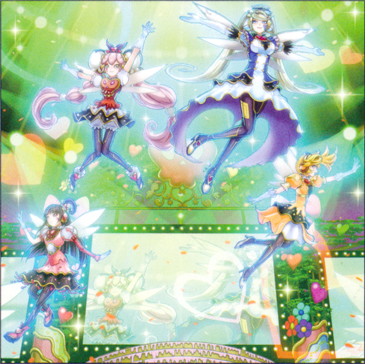It’s that time once again…Today the spotlight falls upon those inflammatory idols famed (and feared) worldwide: the Trickstars!
For you viewers at home out there just tuning in, Trickstar is a theme of LIGHT Fairy monsters first introduced last April in the OCG set Code of the Duelist, and as the deck of choice for Yu-Gi-Oh VRAINS heroine Aoi Zaizen. It’s become quite well-known since its inception, but not only for its anime billing and cutesy art style; the Trickstar deck’s burn effects and disruption abilities allow it to go toe-to-toe with some of the metagame’s top threats.
This article is a little different than most of my previous entries, as the overall motif and gimmick for Trickstars is now much more apparent than it was on their initial OCG release: almost all Trickstar monsters are based on some sort of poisonous flower or plant. This would be the reason for their burn strategy, as well as the “Trick” in “Trickstar”.
That said, I do still find it interesting to show how the names of some of these girls changed in the jump from OCG to TCG, as well as uncovering the basis for some of the more obscurely named Trickstars…so better late than never, I suppose?
I’ll also be taking a look at the deleterious effects of the plants used as motifs where possible. There’s really not any relation between the flowers used and the cards’ individual effects, but it adds another layer of intrigue (or annoyance) to the Trickstars, depending on your history with the deck.
So put your hands together and have 911 on speed dial – the Trickstars are taking center stage!
CODE OF THE DUELIST
As the debut booster for the Trickstar theme, COTD doesn’t beat around the bush (haaah) when it comes to establishing the deck’s motif – all but one card, Trickstar Light Stage, are based on some kind of plant. Curiously enough, this initial bunch also shows off one monster that’s notably not based on something poisonous…can you guess which one?

Trickstar Lilybell
Our first Trickstar has an identical name in both the TCG and OCG!…though this isn’t entirely uncommon for this group. It’s named after the lily of the valley, Convallaria majalis.
The flower does have an association with bells in both English and Japanese: “May bells” is another colloquial name for the plant, while the Japanese name for the plant, suzuran, literally means “bell orchid” (though it is not actually a member of the orchid family).
Fun fact: All parts of the lily of the valley are poisonous, containing many cardiac glycosides, organic compounds that increase the force of heart contractions but slow heart rate. Super cute.
Trickstar Lycoris/Manjussica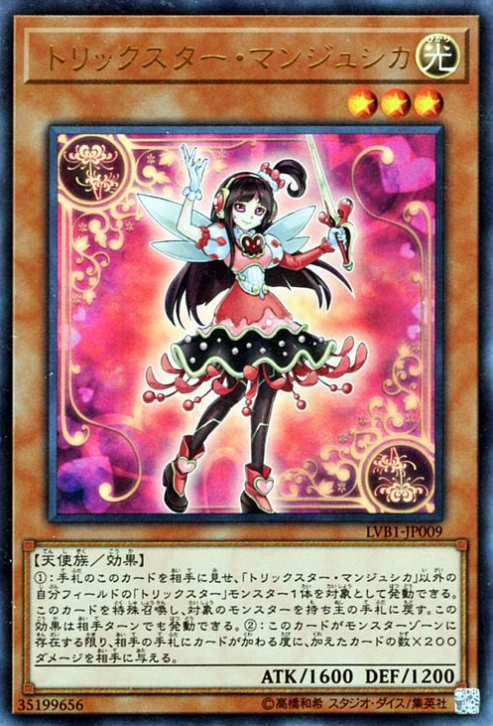
Now here’s a bit more dramatic of a change! Both names come from the red spider lily, Lycoris radiata. Not to be confused with licorice! (Though licorice is probably equally gross.)
While the TCG name is a straight read of the plant name, “Manjussica” is a slight corruption of manjushage or manjushaka, which appears to be a Japanese reading of the plant’s Chinese name. The change to manjushika is likely a mix with the English name “Jessica”, to give the card a more “girly” or “idol-like” name. This is also why we had “Lycorissica” as our early Org localization.
The red spider lily is also known in Japanese as the higanbana, or “flower of the other side”, and is often associated with death or a final meeting with someone. This might be in part because of its striking red color, and partially because its bulbs are very poisonous. This toxicity was also used to farmers’ benefits, keeping pests away from rice paddies and other crops.
 Trickstar Candina
Trickstar Candina
Another Trickstar whose name remained identical – I did say this wasn’t uncommon. Candina appears to be based on the group of flowers known as angel trumpets, with the name probably coming specifically from the species Brugmansia candida. (My guess is that the “-ina” is meant to be another feminine-sounding ending.)
Not just candida, but all angel trumpets are poisonous. The most dangerous parts of an angel trumpet are the leaves and seeds, but the entire plant can be poisonous. Angel trumpets contain tropane alkaloids, some of which are known to induce delirium or terrifying hallucinations. This is also the reason that the card Angel Trumpeter references “delusional mist” in its flavor text – and probably why the art for the (currently anime-only) Spell Card Trickstar Hallucination/Vision showcases Candina.
Trickstar Holly Angel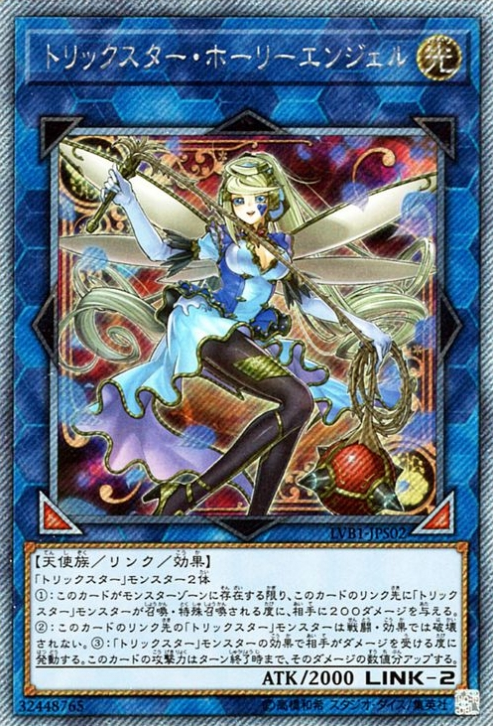
The original ace monster for the Trickstars, Holly Angel is actually based on two plants: Alcea, the family of flowers known as hollyhocks, and Ilex, the holly family. (Note the thorns and berry-like tip on the whip.)
As you may have guessed, the “Holly” portion of the name is derived from both of these plants. It is also a play on “holy”, which, when transliterated into Japanese, sounds all but identical to “holly”.
The Yu-Gi-Oh VRAINS anime provides a little more background to this one, though. Holly Angel is also the ace monster of Aoi Zaizen, who goes by the online alias of Blue Angel. Those of you more familiar with Japanese may recognize “aoi” as the word for “blue”, and that is likely being referenced here. However, the kanji used for Aoi’s name actually means “hollyhock” itself! In other words, Holly Angel is a play on “holy”, “holly”, “hollyhock”, a name that means “hollyhock”, and the nickname Blue Angel. Pretty impressive to cram all that into a two-word name!
As for the plants themselves, holly is certainly known to be toxic, with both its berries and leaves causing nausea, vomiting, and diarrhea. (Festive!) However, hollyhock is notable for being the first plant on the list to not be poisonous (well, at least when compared to the rest – anything can be poisonous with the right dose). In fact, the plant has been used to soothe inflammation due to its ability to coat the mucous membranes and gastrointestinal tract (though touching some types of hollyhock can cause skin irritation). Perhaps this is intentional, since Holly Angel does seem to be the “face” of the Trickstars as well as the “avatar” monster for a major character in the anime.
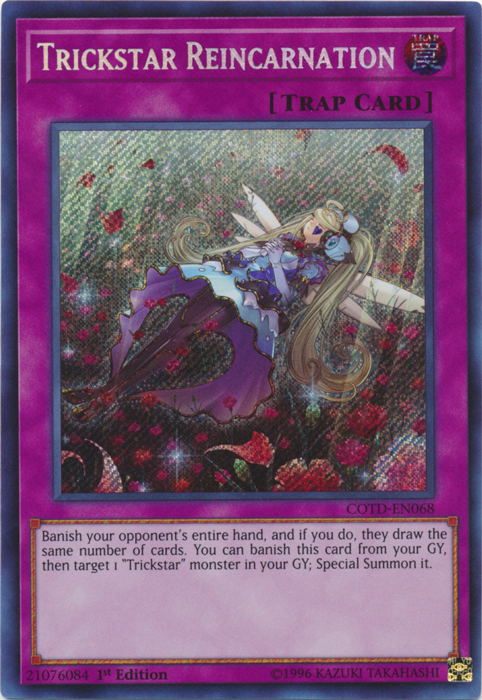 Trickstar Reincarnation
Trickstar Reincarnation
In what may be the only instance of such an occurrence, Reincarnation is the first non-monster Trickstar card to reference a specific flower! Named, as you might expect, after carnations, the flowers of the Dianthus family – and, of course, reincarnation.
While they can contain mild skin irritants in their leaves, carnations are not particularly toxic – it’s more likely that they were chosen here for the wordplay.
CIRCUIT BREAK
The second set of the VRAINS era comes with a surprising dearth of new Trickstars – only 2 monsters were introduced this set. A card related to Trickstars in the anime does make its appearance here, and does contain another plant reference, but isn’t actually a Trickstar itself.
Trickstar Narkissus/Narkiss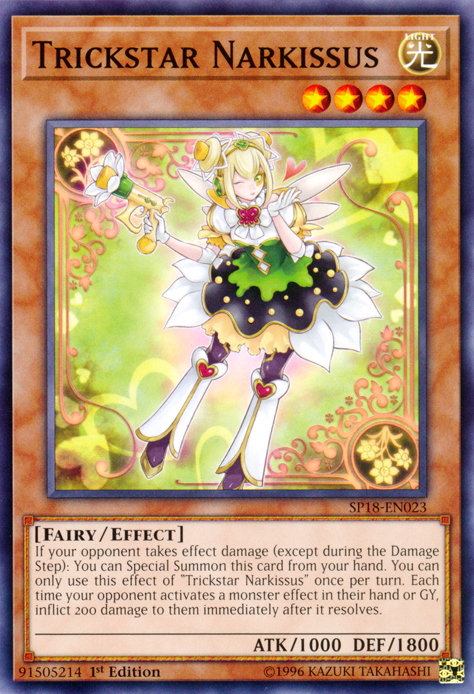
Based on the Narcissus family of flowers – in other words, daffodils. The name is a combination of “narcissus” and “kiss” in both the TCG and OCG. Very idol-y, I guess.
All Narcissus flowers contain poison in their bulbs and leaves, though the amount and distribution differ between species. This poison, an alkaloid known as lycorine, induces nausea, vomiting, and diarrhea, as well as convulsions and paralyis. So, like, don’t eat any daffodils if you were planning on that.
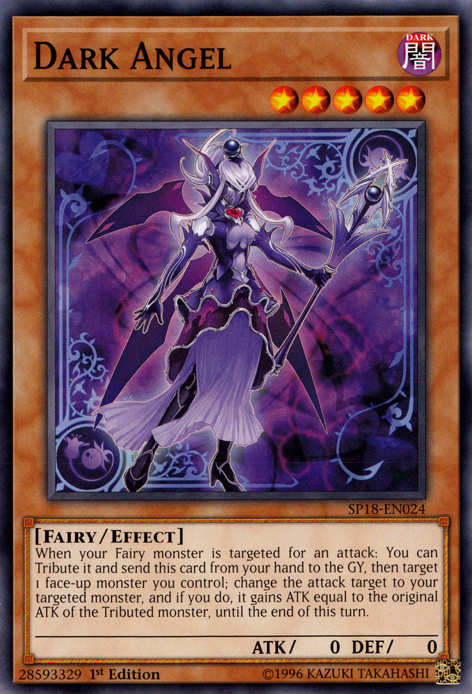 Dark Angel
Dark Angel
I can’t believe it’s not Trickstar! This card appeared in the anime as the result of a virus slipped into Aoi Zaizen’s deck, where it also had a variety of mind-control effects that the real version thankfully lacks.
While the name is rather generic, the card art suggests a basis on Atropa belladonna, or deadly nightshade – specifically, its large black berries. Like angel trumpets, deadly nightshade contains lots of tropane alkaloids, those funky chemicals that cause all sorts of nasty hallucinations, nausea, death, etc. It’s got quite a history as a poison, medicine, and even cosmetic…but mostly poison. And it wasn’t too great at those non-poison applications.
Trickstar Black Catbat/Sweet Devil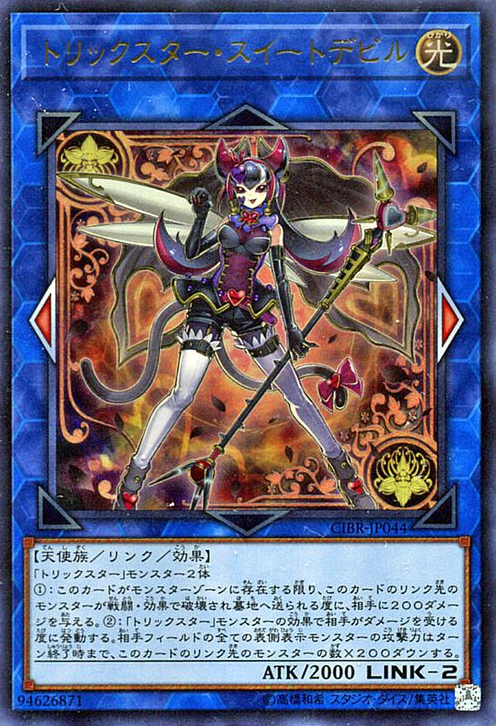
Based on Tacca chantrieri, the black batflower. Other colloquial names include devil flower (for its striking black color and wing-like petals) and cat’s whiskers (for its whiskerlike protrusions).
The TCG name for the card clearly draws from the flower’s less demonic monikers (demonikers?), and intriguingly there are enough cat-themed aspects to the monster’s design that the name doesn’t come completely out of left field. Perhaps knowledge of the plant’s multiple names influenced the art from the very beginning?
Meanwhile, the OCG’s name goes for the devilish reference, while also connecting it nicely with Trickstar Holly Angel to make a duet of Link-2s. The “Sweet” part, on the other hand, likely comes from the fact that the batflower belongs to the yam family Dioscoreaceae – take into account how often yams and sweet potatoes are lumped together, and bam, you’ve got a nice little Trickstar name. Or you’re performing unsavory rituals at the Thanksgiving dinner table. I dunno, you do you.
From the research I’ve done, there isn’t much evidence to suggest that the black batflower is particularly poisonous either – it may just look scary. On the other hand, certain kinds of yams are poisonous when raw, and others are just poisonous, so there may be a little more to this plant than its spooky looks.
FLAMES OF DESTRUCTION
After a complete disappearance from Extreme Force, Trickstar came back with a vengeance in Flames of Destruction, with a whopping eight new cards. Many of these cards haven’t seen as much play thanks to their shift away from disruption and towards repeated Link Summons, but we’re here for some flower references – and six of those new cards certainly deliver on that front. (Technically, Trickstar Bouquet does as well, but we’re looking for cards referencing specific plants, so that’s a no-go.)
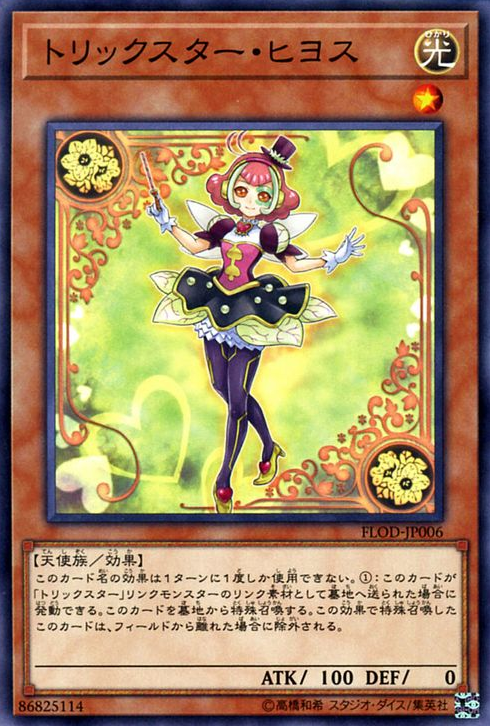 Trickstar Nightshade/Hiyosu
Trickstar Nightshade/Hiyosu
Our first new member is based on Hyoscyamus niger, the henbane or stinking nightshade. Both the TCG and OCG names are fairly straightforward, with hiyosu simply being the Japanese name for henbane. (Which in turn appears to come from the “Hyos” portion of the scientific name Hyoscyamus!) Why the TCG chose Nightshade when there are other Trickstars more specifically based on the more well-known deadly nightshade, I’m not sure. But it does sound nicer than Henbane…or Stinky.
As a member of the nightshade family Solanaceae, the henbane also contains tropane alkaloids, though to a lesser degree than its deadlier relatives. Low doses result in hallucinations and restlessness, while larger doses can cause dizziness, tachycardia, vomiting, convulsions, and/or death.
Trickstar Mandrake
While some of you may be familiar with the mandrake of folklore – a mysterious plant with a human-shaped root that screams when unearthed – the family of Mandragora plants is very real, though with less occult powers and/or screaming. It is, however, quite poisonous, containing a delightful cocktail of everyone’s favorite: tropane alkaloids! In addition to the usual bout of symptoms these chemicals induce, consuming enough mandrake root can also bring about unconsciousness. Or, you know, death, but at this point in the list you should be expecting that.
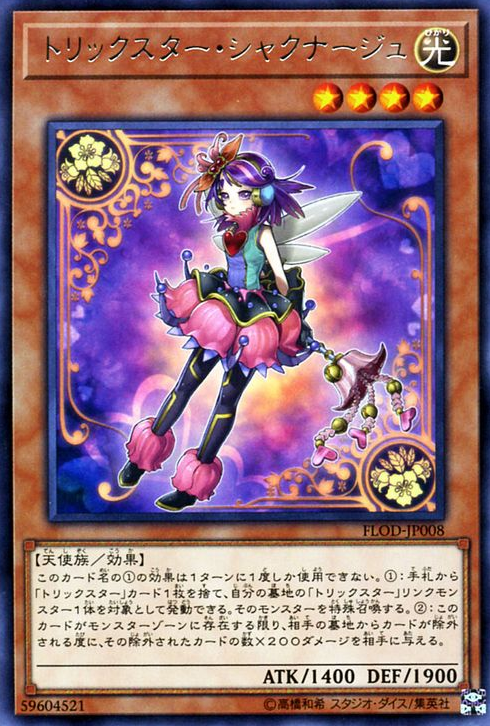 Trickstar Rhodode/Shakunage
Trickstar Rhodode/Shakunage
Alrighty, finally another Trickstar with a name requiring some explanation. Savor it.
As the TCG name suggests, this gal is based on the Rhododendron genus of flowers on either side of the pond, but there’s a little bit of extra cuteness in the OCG name. Shakunage (pronounced “sha-ku-nah-geh”) is indeed the Japanese name for the rhododendron, but the name of the card is pronounced as if you read the word similar to “corsage” or “potage”: shakunaaju (think “sha-ku-nahj”). It’s honestly kind of a cool way to do wordplay, deliberately leaning in on how someone unfamiliar with Japanese would read the romanization of the word.
The TCG’s Rhodode does a decent job of a similar pronunciation play, taking what’s normally part of the vocalized “den” in “rho-do-den-dron” and turning it into a little name-ending-thing.
For those of you on the East Coast of the US, it should come as little surprise to hear that rhododendrons are poisonous. The source of their punch is grayanotoxins, a group of neurotoxins that cause lowered blood pressure, nausea, and an altered state of consciousness. Fun fact: these toxins also end up in any honey created by bees that gather pollen or nectar from them, along with the rip-roaring good time* ingestion of said toxins causes! On the flipside, rhododendron poisoning is also much deadlier for other animals, which is why it’s common to advise keeping pets away from any such flowers.
*Exact degree of rip-roaring and/or good time may vary, consult your local doctor.
Trickstar Bella Madonna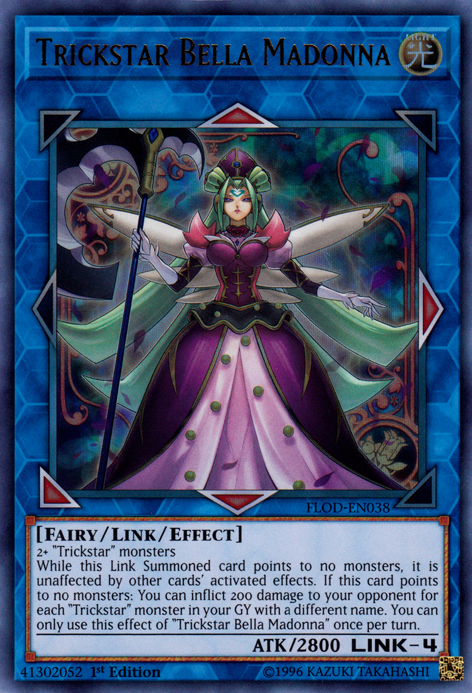
Remember that Dark Angel card from further up the page? Same plant here: Atropa belladonna, the deadly nightshade. This time, though, it’s playing on the other name of the plant, belladonna. Not much more to it than that!
On a side note, I do wonder if this card was intentionally themed after nightshade in the wake of Dark Angel, since this card is decidedly “good” and used in a climactic moment in the anime. If it is supposed to be a callback, it’s decently clever – the plant that once dragged Aoi into “evil” is now the most powerful (or at least the only LINK-4) card she has.
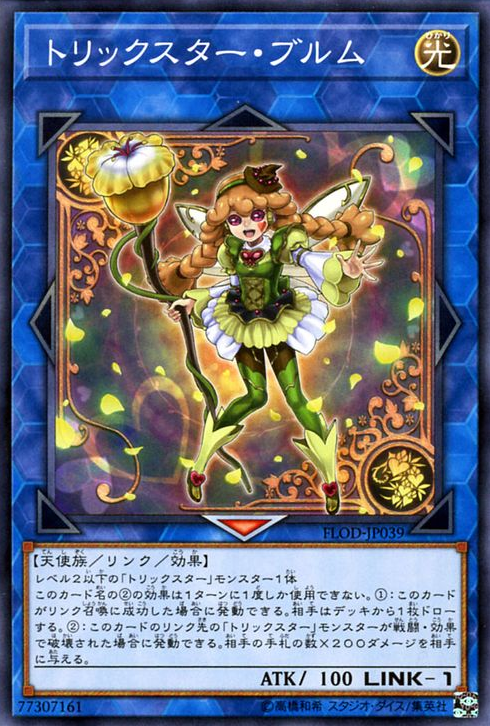 Trickstar Bloom/Broom(?)
Trickstar Bloom/Broom(?)
Ah, good old L/R confusion. It would be an easy guess that this card’s OCG name is the same as its TCG moniker, Bloom – if not for its basis on Cytisus scoparius, a flower known as the common broom or Scotch broom. Maybe it’s both, punning in a way English can’t. Whatever the cause, there’s certainly enough bloominess and broominess to make either name stick.
The broom flower is indeed poisonous, causing symptoms such as muscle tremors, diarrhea, vomiting, and increased heart rate, though fatalities are rare.
Trickstar Delfiendium/Devilphinium 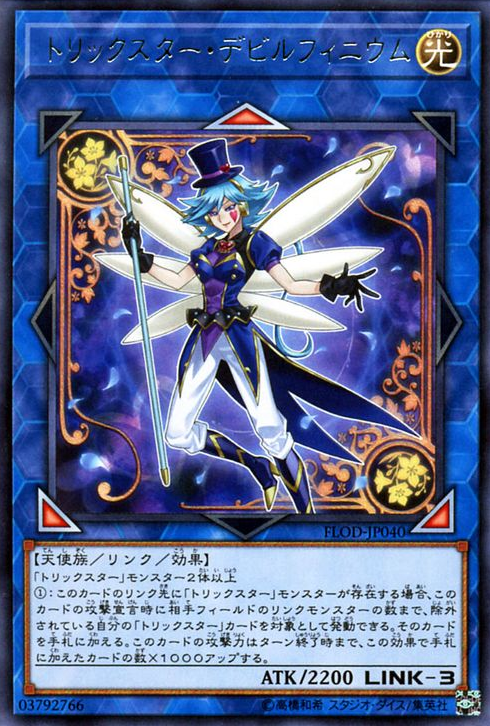
One of those rare times when the TCG’s avoidance of the word “devil” managed to still keep a pun! The wordplay is basically the same in the OCG and TCG: combining a “devil” word with the flower genus Delphinium, and conveniently you can squish “fiend” in there without much worry.
All members of Delphinium are toxic to humans, and often fatally so to livestock. Neat! This is primarily thanks to diterpinoid alkaloids, which cause symptoms such as loss of motor control, agitation, gastrointestinal inflammation, muscle spasms, respiratory issues, and more.
PROMOTIONAL CARDS
Although support has been somewhat sporadic as far as main set releases go, Trickstars have received a surprisingly generous amount of cards from various promotions, such as subscription promos, inclusions with magazine issues, and limited edition sets. Among these cards, three of them so far have referenced specific flowers. (Unfortunately, like the aforementioned Trickstar Bouquet, Trickstar Magicorolla is not referring to a type of flower. Rather, it suggests a small garland or wreath known as a corolla.)
 Trickstar Crimson Heart/Bloody Mary
Trickstar Crimson Heart/Bloody Mary
For a while, consensus seemed to suggest that this card was named after the “Double Bloody Mary”, a cultivar of the Geum family. However, after looking into the art and researching in greater detail, it seems much likelier that the Lamprocapnos family of flowers, colloquially known as bleeding hearts, are the origin of this particular Trickstar. This also explains why the TCG’s name uses “Heart” – if “Bloody” was cutting it too close for comfort, the other half of the flower’s name was still viable.
Of course, the OCG name itself is also a reference to Bloody Mary, which is either a popular urban legend, or a nickname for the historically violent Queen Mary I of England. And, I guess, also a well-known brunch cocktail of tomato juice and vodka. Spooky.
All parts of the plant are poisonous; they can cause skin irritation if touched, and the usual host of alkaloid-based symptoms if ingested, such as trembles, vomiting and diarrhea, and respiratory trouble. However, they do not appear to cause many serious poisoning incidents among healthy adults.
Trickstar Carobane(?)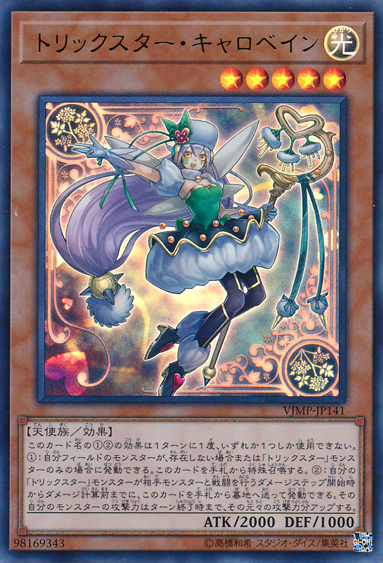
Now this one in particular has been a little tricky – the name isn’t super clear, the art suggests a number of different potential motifs, and on top of all that, it’s one of the more commonly used Trickstars, so I get to be reminded constantly that we never really settled on a name for it.
After looking around on some Japanese wiki pages, though, I have come upon a slightly more feasible option: the Actaea family, also known as the baneberry. Known for its attractive, often white or red, and always poisonous berries, the baneberry plant is chock full of delicious heart-stopping (or slowing) poison, which can lead to cardiac arrest and (say it with me now) death.
In addition to meeting the poison check for Trickstars, this also easily fits into the name Carobane. While the “Caro-” portion may also be a reference to caroling and other Christmas frivolities (as the card’s overall outfit and release date were quite Christmassy), it may also be a “plant + girl name” in the style of some earlier Trickstars. After all, the difference between “Caroline” (kyarorain) and “Carobane” (kyarobein) only requires the swapping of a single kana.
 Trickstar Foxywitch
Trickstar Foxywitch
Last but not least on our list is the criminally underappreciated Foxywitch, from the LINK VRAINS BOX released last November. As many may have guessed upon first seeing the card and its name, it is most certainly based on the Digitalis, or foxglove, genus of flowers. However, the “witch” portion of its name isn’t just the usual feminine addition: it comes from “witch’s glove”, a colloquial name for the flowers which may derive from their toxicity.
And of course they’re toxic, what did you expect? Digoxin, the main poisonous substance in foxgloves, can cause dizziness, vomiting, vertigo, and blurred vision among other symptoms, though the most dangerous effects are those on the heart – depending on the individual, it causes an increase or decrease in heartbeat, or other irregularities.
That’s all for now, folks! Hopefully this peek into the backstage secrets of the Trickstars has helped endear them a little more to you. Or maybe now the sight of flowers will drive you into a berserk rage? One of the two. And with the new set Soul Fusion on the horizon, as well as an Aoi-centered episode of VRAINS set to air quite soon, we may see a brand new arrangement of floral femme fatales get their moment in the spotlight! Maybe your very own favorite poisonous flower will be next?
I mean, if you have a favorite poisonous flower, I guess.
Nerd.
All images sourced from Yugipedia.com.

